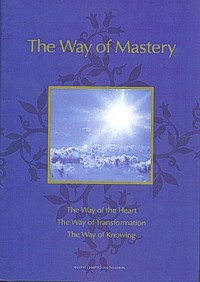For as long as I can remember, I’ve played this sort of game with myself and the Universe whereby I walk into a book store and allow myself to be directed to something that I need to read at a particular time. I always remember these events and the books chosen. When I look back, I understand the effect the book had and how it led to other events and knowledge which helped me along the way.
This is what happened about 10 years ago. I was going through a particular search for meaning and purpose and made regular journeys to our local book store here in Bellingham, Washington. At this time I read everything from Bhagavad Gita to Autobiography of a Yogi to The Power of Now and it was in the Introduction to The Power of Now that I first glimpsed the words, A Course in Miracles. After that, the title would come up in other books until I was convinced that someone or something was trying to tell me something.
Like most people, my first experience with ACIM was a combination of fascination, euphoria, gratitude and sheer terror. What it was telling me was that everything, and I mean everything, I believed, everything I thought I knew and understood, was not reality. Over time, after reading the text several times over and painstakingly completing the workbook, it became a central part of my life. And so it remains.
That said, it hasn’t stopped my searching for more. My frequency in book stores has diminished, but when I do go I feel compelled as though someone or something is literally pushing me though the door and leading me to a new jewel.
Recently, I came across The Christ Blueprint, by Padma Aon Prakasha. On a trip to the sacred sites in southern France he had an experience whereby, while sitting down to dinner he recounts: “a form appeared right in front of us, followed by two others. It was a woman, radiant, beautiful, soft, and very present. Behind her was a shadowy figure of a man. She turned and looked toward me, and my heart stopped. It was Mary Magdalene.” [The Christ Blueprint, Preface x] Prakasha, the author, then becomes a channel for various historical characters of religious and spiritual significance which he claims came to him in a sort of holographic vision. He would speak the words while his partner transcribed.
This book in itself is hugely interesting and one I would like to write about at another time. I bring it up because it is what led me to the topic of this article. Again, one written word leading me to another.
Chapter 7 in The Christ Blueprint is composed of words given to the author from Saint Germain on the topic of Alchemy. It is about transformation and about opening our hearts and minds to truths that have been written and practiced over the ages but also buried and blocked by the world as we know it. He recommends tapping into the four traditions; the Egyptian, Indian, Tibetan, and Hebrew. Then he says, “In modern times, Yeshua’s A Course in Miracles and the Way of Mastery books hold direct teachings on the nature of Christ Mind.” [CB, p142-143] With the spiritual kick in the butt, I, of course, had to find and read this Way of Mastery. I figured if Saint Germain himself acknowledges ACIM as the groundbreaking and transformative book that I also believe it is and puts Way of Mastery in the same category and having the same author and voice, then that is certainly the book for me.
The Way of Mastery has not disappointed. Without going much into its history and somewhat turbulent publication, it has much in common with ACIM in form and content. Like ACIM it was published anonymously, has the familiar blue binding and has Jesus or Yesuha as the author and voice.
What strikes me as different about the two texts is more in tone and tenor. If you are among the many who strugg le with the text of ACIM, either because of the way it is written, its more cerebral format or its religious wording, then you might find Way Of Mastery, exceedingly refreshing, enlightening, exciting and extremely practical. To me, it reads like a no-holds-barred Jesus, imploring us to follow our hearts desire, to stop fearing and start living our “grand self,” and this hit home for me, to stop being a seeker. Instead, be a finder.
le with the text of ACIM, either because of the way it is written, its more cerebral format or its religious wording, then you might find Way Of Mastery, exceedingly refreshing, enlightening, exciting and extremely practical. To me, it reads like a no-holds-barred Jesus, imploring us to follow our hearts desire, to stop fearing and start living our “grand self,” and this hit home for me, to stop being a seeker. Instead, be a finder.

